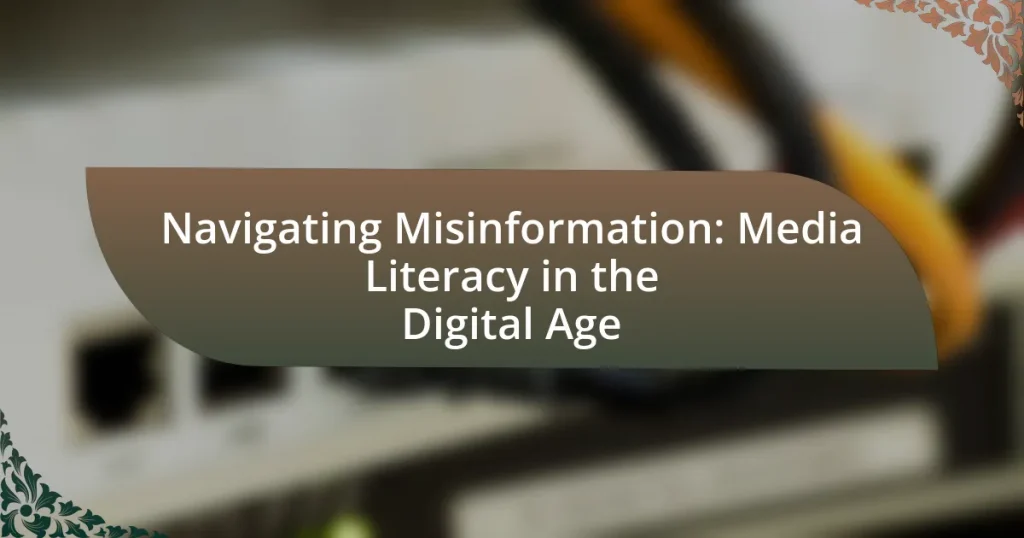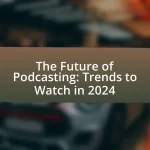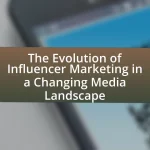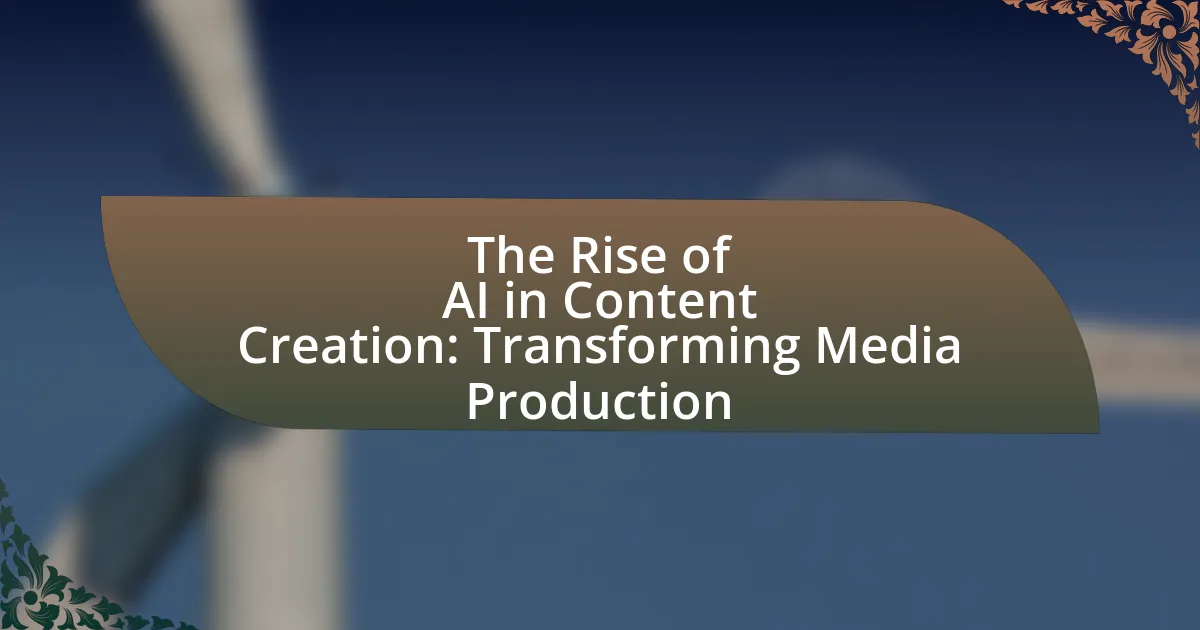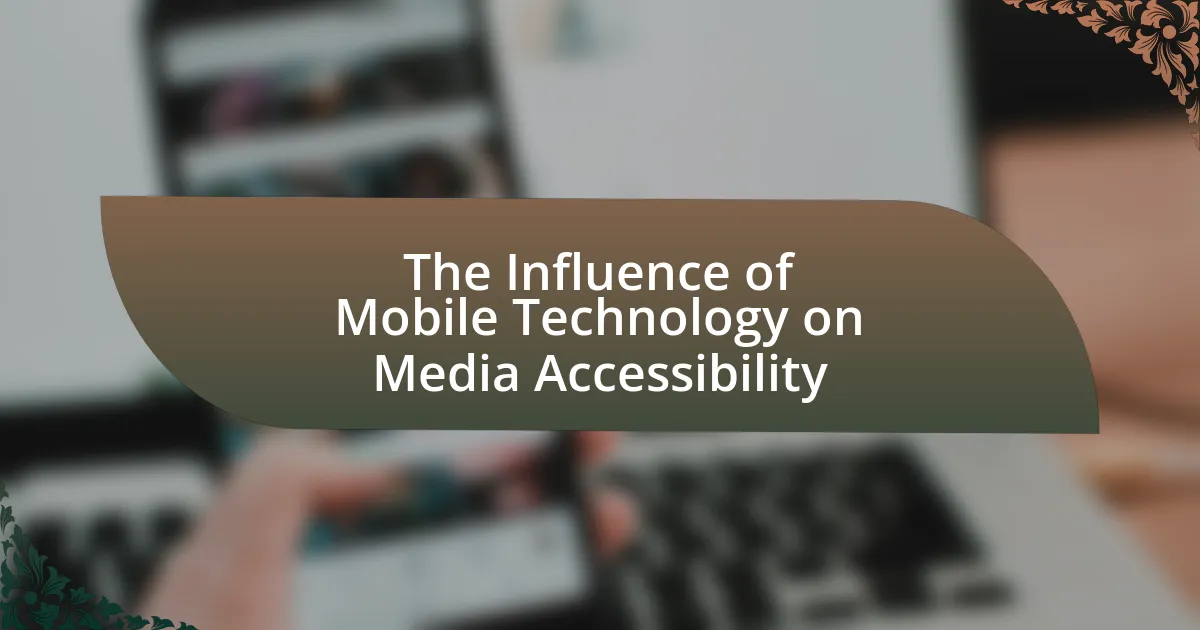Misinformation in the digital age refers to false or misleading information spread through digital platforms, often without malicious intent. This article explores the mechanisms of misinformation dissemination, particularly through social media, where algorithms prioritize engagement over accuracy, leading to the rapid spread of inaccuracies. It emphasizes the importance of media literacy in combating misinformation, detailing essential skills for critical evaluation of information sources and the impact of misinformation on public perception, health, and democratic processes. The article also outlines practical strategies for individuals to enhance their media literacy skills and navigate the complexities of digital information effectively.
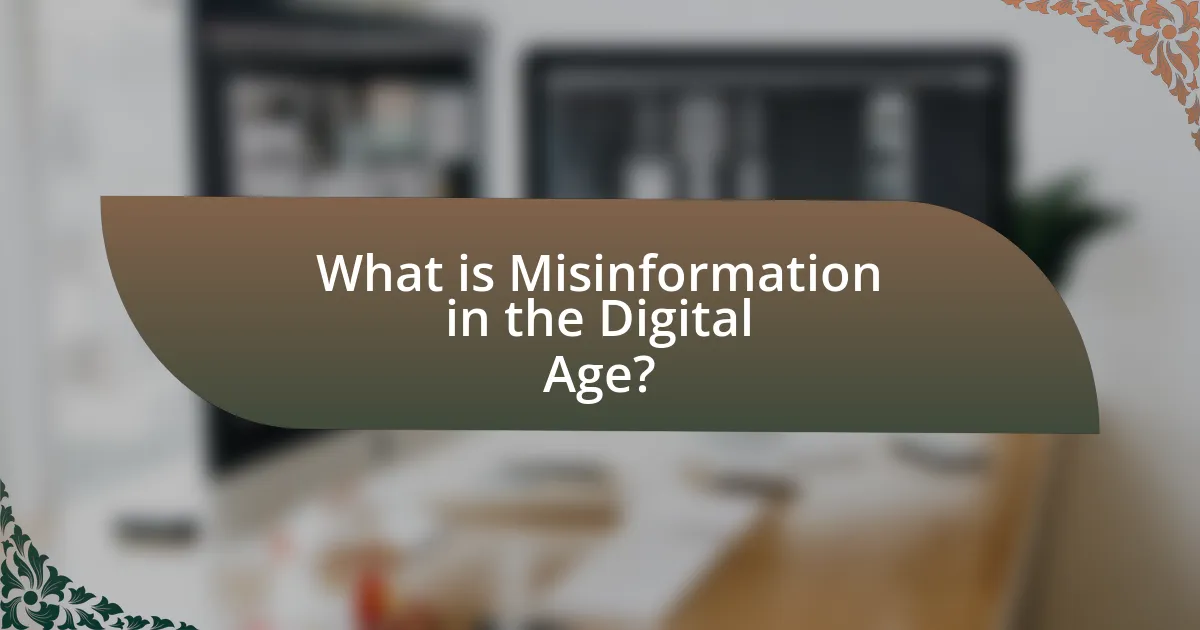
What is Misinformation in the Digital Age?
Misinformation in the digital age refers to false or misleading information disseminated through digital platforms, often without malicious intent. This phenomenon is exacerbated by the rapid spread of information via social media, where users can share content widely and quickly, leading to the viral propagation of inaccuracies. According to a study by the Pew Research Center, 64% of Americans believe that misinformation is a major problem in society, highlighting its prevalence and impact on public perception and decision-making.
How does misinformation spread through digital media?
Misinformation spreads through digital media primarily via social networks, where users share content rapidly without verifying its accuracy. The design of platforms like Facebook and Twitter encourages engagement, leading to the viral dissemination of misleading information. A study by Vosoughi, Roy, and Aral in 2018 found that false news stories are 70% more likely to be retweeted than true stories, highlighting the propensity for sensational content to capture attention. Algorithms that prioritize engagement over accuracy further exacerbate this issue, allowing misinformation to reach wide audiences quickly.
What role do social media platforms play in the dissemination of misinformation?
Social media platforms significantly contribute to the dissemination of misinformation by enabling rapid sharing and amplifying false narratives. These platforms facilitate the spread of unverified information due to their algorithms, which prioritize engagement over accuracy, leading to viral misinformation. A study by the Massachusetts Institute of Technology found that false news stories are 70% more likely to be retweeted than true stories, highlighting the platforms’ role in amplifying misleading content. Additionally, the lack of stringent fact-checking mechanisms allows misinformation to proliferate unchecked, further exacerbating the issue.
How do algorithms contribute to the spread of false information?
Algorithms contribute to the spread of false information by prioritizing engagement over accuracy, leading to the amplification of sensational or misleading content. Social media platforms and search engines utilize algorithms that favor posts with high interaction rates, such as likes, shares, and comments, regardless of their truthfulness. Research by the Massachusetts Institute of Technology found that false news stories are 70% more likely to be retweeted than true stories, highlighting how algorithmic bias towards engagement can facilitate the rapid dissemination of misinformation.
Why is media literacy important in combating misinformation?
Media literacy is crucial in combating misinformation because it equips individuals with the skills to critically analyze and evaluate information sources. By fostering critical thinking, media literacy enables people to discern credible information from falsehoods, thereby reducing the spread of misinformation. Studies indicate that individuals with higher media literacy are less likely to believe and share false information; for instance, a 2020 study published in the Journal of Media Literacy Education found that media literacy education significantly decreased susceptibility to misinformation among participants. This demonstrates that enhancing media literacy is an effective strategy for mitigating the impact of misinformation in the digital age.
What skills are essential for effective media literacy?
Critical thinking, analysis, evaluation, and communication are essential skills for effective media literacy. Critical thinking enables individuals to assess the credibility of sources and discern bias in information. Analysis involves breaking down media messages to understand their components and intentions. Evaluation requires individuals to judge the reliability and relevance of information, while communication skills facilitate the sharing of insights and discussions about media content. These skills collectively empower individuals to navigate misinformation effectively in the digital age.
How can media literacy empower individuals to discern credible sources?
Media literacy empowers individuals to discern credible sources by equipping them with critical thinking skills and the ability to analyze information effectively. This skill set enables individuals to evaluate the reliability of sources based on criteria such as authorship, publication date, and the presence of citations. Research indicates that individuals with strong media literacy skills are more adept at identifying misinformation; for example, a study by the Stanford History Education Group found that 96% of high school students could not distinguish between a sponsored post and a news article. This highlights the necessity of media literacy in fostering informed decision-making and promoting the consumption of credible information.

What are the types of misinformation encountered online?
The types of misinformation encountered online include false information, misleading information, and disinformation. False information refers to completely inaccurate content that is presented as fact, such as fabricated news stories. Misleading information involves presenting facts in a way that creates a false impression, such as selectively quoting sources to distort their meaning. Disinformation is deliberately false information spread with the intent to deceive, often seen in political propaganda. According to a study by the Pew Research Center, 64% of Americans believe that misinformation is a major problem in society, highlighting the prevalence and impact of these types of misinformation online.
How do different forms of misinformation impact public perception?
Different forms of misinformation significantly distort public perception by shaping beliefs and attitudes based on false or misleading information. For instance, studies show that misinformation can lead to increased polarization, as individuals may adopt extreme views based on inaccurate narratives, such as those surrounding political events or health crises. A 2020 study published in the journal “Nature” found that exposure to misinformation about COVID-19 led to widespread misconceptions about the virus’s transmission and prevention, ultimately affecting public health behaviors. Furthermore, misinformation can erode trust in institutions, as individuals may question the credibility of news sources and experts when confronted with conflicting information. This erosion of trust can have long-lasting effects on societal cohesion and democratic processes.
What distinguishes misinformation from disinformation and malinformation?
Misinformation is false or misleading information spread without the intent to deceive, while disinformation is deliberately false information shared with the intent to mislead. Malinformation, on the other hand, involves the sharing of true information with the intent to cause harm or mislead in a specific context. For example, misinformation can occur when someone shares an incorrect statistic without verifying its accuracy, disinformation is evident when a person fabricates a news story to manipulate public opinion, and malinformation can be seen when private information is leaked to damage someone’s reputation. This distinction is crucial for understanding the different motivations and impacts of various types of false information in media literacy.
How can individuals identify various types of misinformation?
Individuals can identify various types of misinformation by critically evaluating the source, content, and context of the information presented. Critical evaluation involves checking the credibility of the source, such as verifying the author’s qualifications and the publication’s reputation. Additionally, individuals should analyze the content for signs of bias, sensationalism, or emotional manipulation, which are common indicators of misinformation. Contextual analysis includes understanding the purpose of the information and its alignment with established facts. Research indicates that media literacy programs significantly enhance individuals’ ability to discern misinformation, as demonstrated by a study published in the Journal of Media Literacy Education, which found that participants who underwent media literacy training were 50% more likely to identify false information accurately.
What are the consequences of misinformation on society?
Misinformation leads to significant societal consequences, including erosion of trust in institutions, polarization of communities, and detrimental impacts on public health. Trust in government and media decreases as individuals encounter conflicting information, resulting in skepticism and disengagement from civic processes. Research from the Pew Research Center indicates that 64% of Americans believe that misinformation has a major impact on their trust in news sources. Additionally, misinformation fosters polarization by reinforcing existing biases, as individuals gravitate towards information that aligns with their preconceptions, creating echo chambers. This division can escalate social tensions and conflict. In the realm of public health, misinformation can lead to harmful behaviors, such as vaccine hesitancy, which the World Health Organization has identified as a significant barrier to achieving herd immunity. These consequences illustrate the profound effects misinformation has on societal cohesion and well-being.
How does misinformation affect public health and safety?
Misinformation significantly undermines public health and safety by promoting false beliefs and behaviors that can lead to harmful outcomes. For instance, during the COVID-19 pandemic, widespread misinformation about the virus’s transmission and prevention methods resulted in increased infection rates and vaccine hesitancy, as evidenced by a study published in the journal Health Affairs, which found that misinformation contributed to a 30% increase in the likelihood of individuals refusing vaccination. This demonstrates that misinformation not only distorts public understanding but also directly impacts health behaviors, leading to adverse health consequences and increased strain on healthcare systems.
What impact does misinformation have on democratic processes?
Misinformation significantly undermines democratic processes by distorting public perception and influencing voter behavior. It creates confusion, erodes trust in institutions, and polarizes communities, leading to a less informed electorate. For instance, a study by the Pew Research Center found that 64% of Americans believe fabricated news stories cause confusion about the basic facts of current events. This distortion can result in misguided voting decisions, as individuals may base their choices on false information rather than factual evidence. Furthermore, misinformation can facilitate the spread of extremist views, as seen in various elections worldwide, where false narratives have swayed public opinion and affected electoral outcomes.
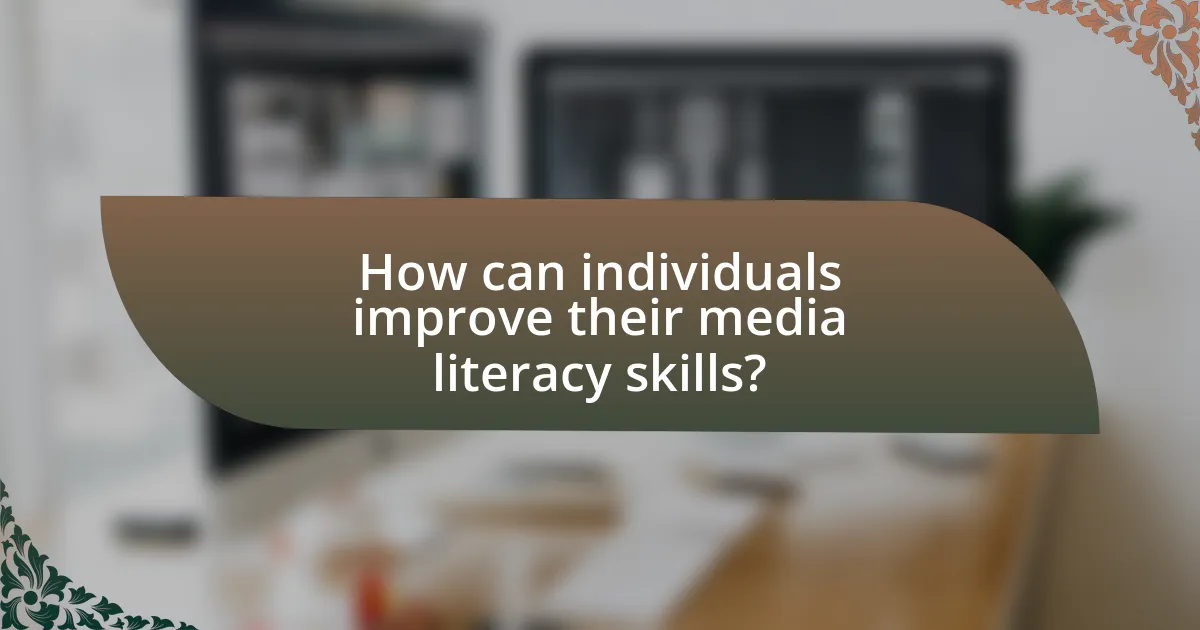
How can individuals improve their media literacy skills?
Individuals can improve their media literacy skills by actively engaging in critical analysis of media content. This involves evaluating the credibility of sources, understanding the purpose behind media messages, and recognizing bias and misinformation. Research indicates that media literacy education enhances individuals’ ability to discern reliable information; for instance, a study by the National Association for Media Literacy Education found that students who participated in media literacy programs demonstrated improved critical thinking skills and a greater ability to identify misinformation. By practicing these skills regularly, individuals can become more adept at navigating the complexities of media in the digital age.
What strategies can be employed to enhance critical thinking regarding media consumption?
To enhance critical thinking regarding media consumption, individuals can employ strategies such as evaluating sources, cross-referencing information, and questioning the intent behind media messages. Evaluating sources involves checking the credibility of the information provider, such as looking for established organizations or experts in the field. Cross-referencing information with multiple reputable sources helps to confirm the accuracy of claims, reducing the likelihood of accepting misinformation. Questioning the intent behind media messages encourages consumers to consider who created the content, why it was created, and what biases may be present. These strategies are supported by research indicating that media literacy education significantly improves critical thinking skills, as shown in studies conducted by the National Association for Media Literacy Education, which highlight the importance of these skills in navigating the complexities of digital information.
How can fact-checking resources be effectively utilized?
Fact-checking resources can be effectively utilized by integrating them into the research and information verification processes. Users should actively consult reputable fact-checking websites, such as Snopes, FactCheck.org, and PolitiFact, to verify claims before sharing or acting on them. Studies indicate that individuals who engage with fact-checking resources are less likely to spread misinformation; for instance, a 2020 study published in the journal “Communication Research” found that exposure to fact-checking significantly reduced the likelihood of sharing false information on social media. By consistently using these resources, individuals enhance their media literacy and contribute to a more informed public discourse.
What role does education play in fostering media literacy among different age groups?
Education plays a crucial role in fostering media literacy among different age groups by equipping individuals with the skills to critically analyze and evaluate information. For children and adolescents, educational programs that incorporate media literacy into the curriculum help develop critical thinking skills, enabling them to discern credible sources from misinformation. Research by the National Association for Media Literacy Education indicates that students who receive media literacy education are better at identifying biased or misleading content.
For adults, continuing education initiatives and community workshops enhance media literacy by addressing the complexities of digital information and social media. A study published in the Journal of Media Literacy Education found that adults who participated in media literacy training reported increased confidence in their ability to navigate online information. Thus, education serves as a foundational tool across age groups, promoting informed decision-making in an increasingly complex media landscape.
What practical tips can help individuals navigate misinformation?
To navigate misinformation effectively, individuals should verify information through multiple credible sources. This practice ensures that the information is accurate and not based on a single, potentially biased source. Research indicates that cross-referencing facts with established news organizations, academic institutions, or official reports significantly reduces the likelihood of accepting false information. Additionally, individuals should be aware of cognitive biases, such as confirmation bias, which can lead to the acceptance of information that aligns with pre-existing beliefs. Understanding these biases can help individuals critically evaluate the information they encounter.
How can one evaluate the credibility of online sources?
To evaluate the credibility of online sources, one should assess the author’s qualifications, the publication’s reputation, and the presence of citations or references. Authors with relevant expertise or credentials enhance credibility, while established publications typically have editorial standards that ensure accuracy. Additionally, credible sources often provide citations to support their claims, allowing readers to verify information. For instance, a study by the Stanford History Education Group found that students often struggled to evaluate online sources, highlighting the importance of critical assessment skills in navigating misinformation.
What steps can be taken to verify information before sharing it?
To verify information before sharing it, individuals should follow a systematic approach that includes checking the source, cross-referencing facts, and evaluating the evidence. First, assess the credibility of the source by looking for established organizations or experts in the field, as reputable sources are more likely to provide accurate information. For instance, a study published in the Journal of Communication found that information from peer-reviewed journals is generally more reliable than that from unverified online platforms.
Next, cross-reference the information with multiple credible sources to confirm its accuracy. This step is crucial because corroboration from different outlets can help identify discrepancies or biases in reporting. Additionally, evaluate the evidence presented, including data, statistics, and citations, to ensure they are from trustworthy origins. For example, if a claim cites a statistic, verify that the statistic comes from a reputable research study or government report.
By implementing these steps—assessing source credibility, cross-referencing, and evaluating evidence—individuals can significantly reduce the risk of spreading misinformation.
